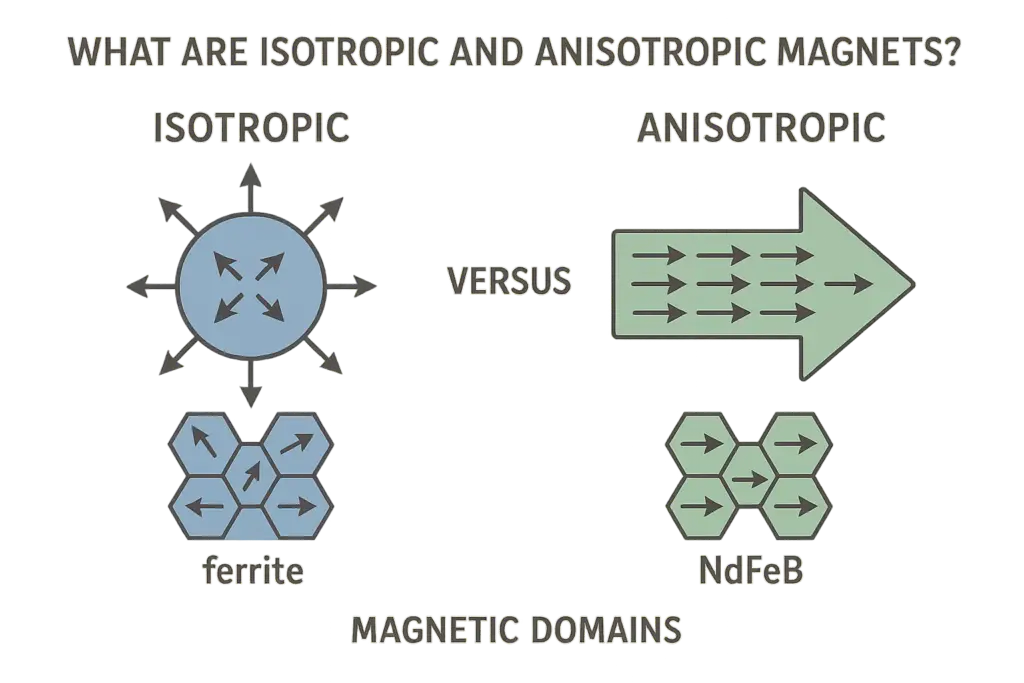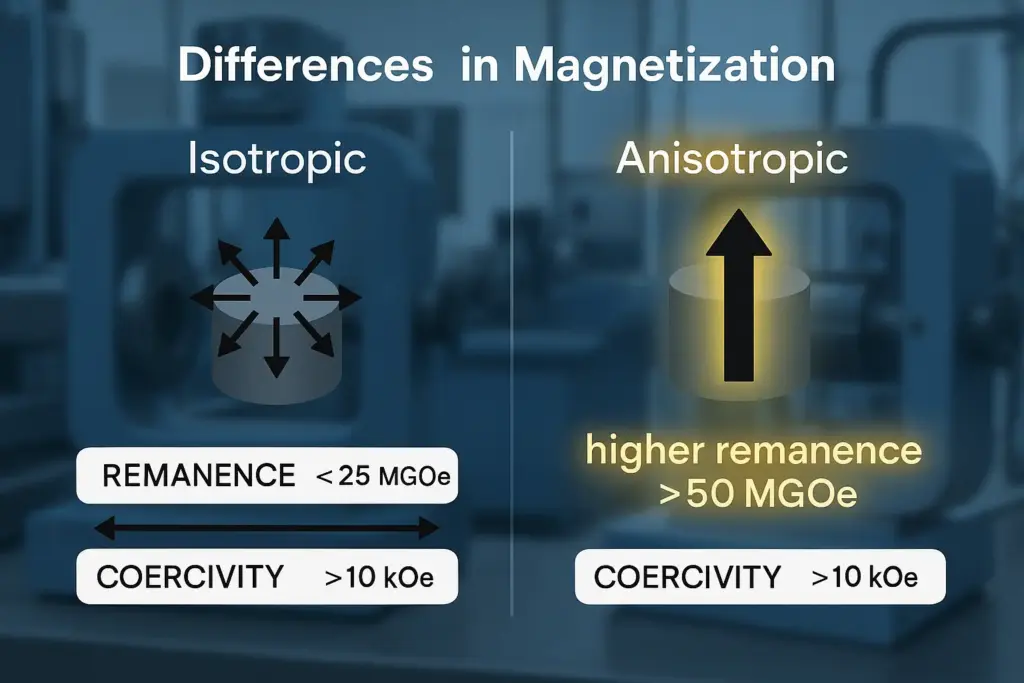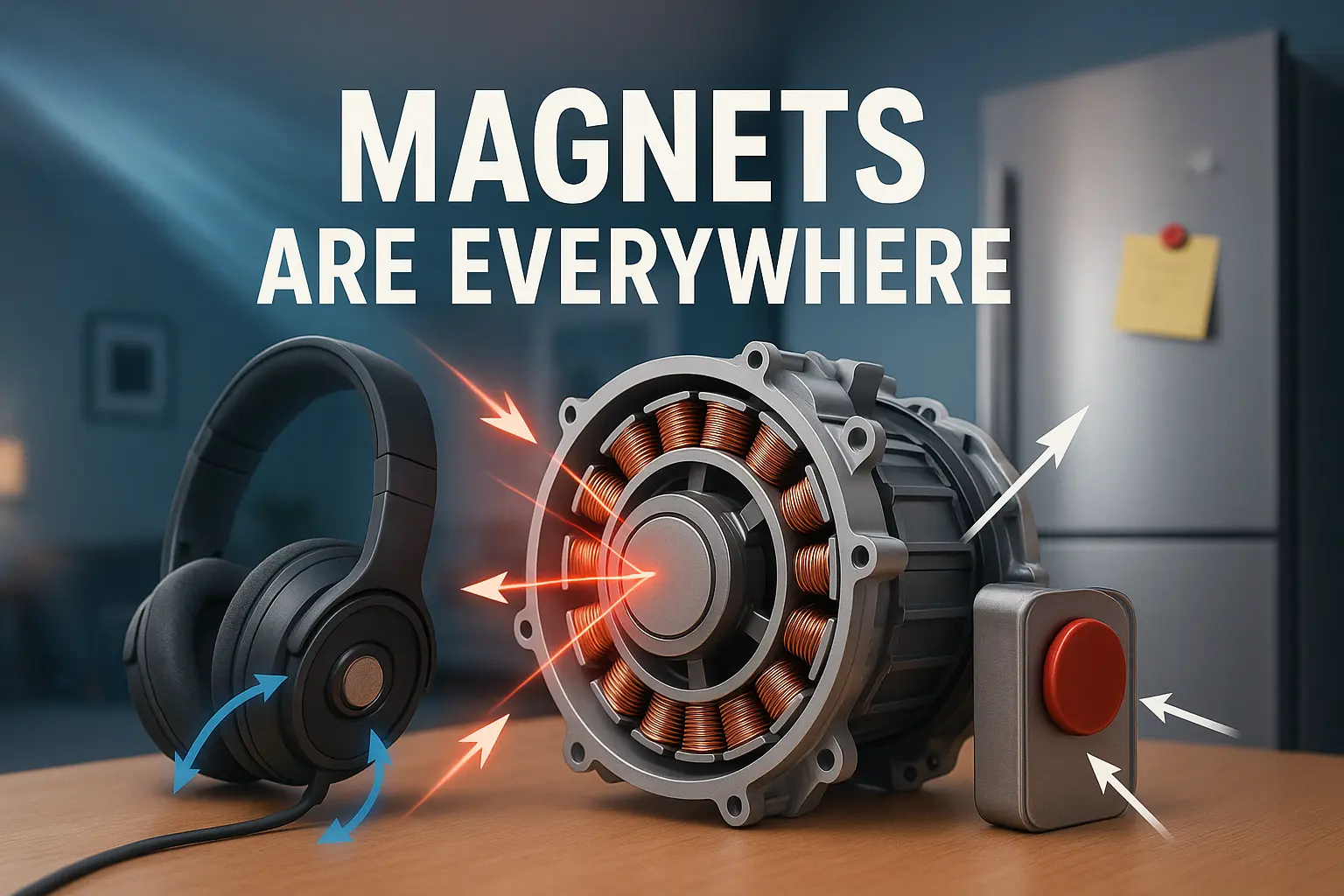Magnets are everywhere in our daily lives—from the speakers in your headphones to the motors in electric vehicles. But not all magnets are created equal. Among the key distinctions in magnet types are isotropic and anisotropic magnets. These terms refer to how the magnetic properties behave in different directions. In this blog post, we’ll break down what isotropic and anisotropic mean, explore their differences in production processes and magnetization, and discuss their practical uses. Whether you’re a hobbyist, engineer, or just curious, let’s dive in!
What Are Isotropic and Anisotropic Magnets?
To start, let’s define these concepts simply.
- Isotropic Magnets: The term “isotropic” comes from Greek roots meaning “equal in all directions.” In magnets, this means the magnetic properties—such as strength and the ability to be magnetized—are uniform regardless of the direction. You can think of it like a sphere: no matter which way you turn it, it behaves the same. Common examples include certain ferrite or alnico magnets that haven’t been specially aligned during manufacturing.
- Anisotropic Magnets: On the flip side, “anisotropic” means “different in different directions.” These magnets have a preferred axis or direction where their magnetic properties are strongest. Outside of that direction, the magnetism is weaker. This alignment makes them more efficient for specific applications. Neodymium (NdFeB) and samarium-cobalt (SmCo) magnets are often anisotropic.
In essence, isotropic magnets are versatile but less powerful in any one direction, while anisotropic ones are like specialized tools—optimized for performance along a particular path.

Differences in Production Processes
The way these magnets are made plays a huge role in their final properties. Here’s how the processes differ:
- Isotropic Magnets Production: These are typically produced without any external magnetic field during the key stages. The raw materials (like powdered metals or ceramics) are mixed, pressed into shape, and then sintered (heated to fuse particles) or cast. Since there’s no alignment force, the magnetic domains (tiny regions within the material that act like mini-magnets) point randomly in all directions. This results in even properties but lower overall magnetic strength. Common methods include dry pressing or injection molding for materials like isotropic ferrites.
- Anisotropic Magnets Production: The magic happens with the application of a strong external magnetic field during pressing or sintering. This field aligns the magnetic domains in a preferred direction as the material solidifies. For instance, in anisotropic ferrite magnets, the powder is pressed in a magnetic field, creating a “texture” where domains line up. For rare-earth magnets like NdFeB, the process might involve melt-spinning or hot deformation to enhance alignment. This extra step makes production more complex and often costlier, but it boosts the magnet’s energy product (a measure of strength).
Overall, isotropic production is simpler and cheaper, ideal for mass production, while anisotropic requires precise control for superior performance.
Differences in Magnetization
Magnetization is the process of turning a material into a magnet by exposing it to a magnetic field. Here’s where the isotropic-anisotropic divide shines:
- Isotropic Magnetization: These magnets can be magnetized in any direction after production because their domains aren’t pre-aligned. You apply a magnetic field, and the domains reorient freely. However, the resulting magnet is generally weaker, with a lower remanence (the magnetism left after the field is removed) and coercivity (resistance to demagnetization). They’re often multi-pole magnetized for applications needing complex patterns.
- Anisotropic Magnetization: These must be magnetized along their preferred axis to achieve maximum strength. Trying to magnetize them in other directions yields poor results because the domains are locked in place. This leads to higher remanence and coercivity—up to several times stronger than isotropic counterparts. For example, an anisotropic NdFeB magnet can have a magnetic energy product over 50 MGOe, compared to under 10 MGOe for isotropic versions.
In short, isotropic magnets offer flexibility in magnetization direction but at the cost of power, while anisotropic ones demand directional precision for peak efficiency.

Practical Usage and Applications
Choosing between isotropic and anisotropic magnets depends on the job at hand. Here’s a quick comparison:
| Aspect | Isotropic Magnets | Anisotropic Magnets |
|---|---|---|
| Strength | Lower (e.g., 1-5 MGOe for ferrites) | Higher (e.g., 30-50 MGOe for NdFeB) |
| Directionality | Any direction | Preferred axis only |
| Cost | Cheaper | More expensive |
| Common Uses | Holding magnets, sensors, educational kits, fridge magnets | Electric motors, speakers, MRI machines, wind turbines |
- Isotropic Uses: Their uniformity makes them great for applications where direction isn’t critical or where multi-directional magnetization is needed. You’ll find them in magnetic separators, loudspeakers (for less demanding audio), or even toys. They’re also preferred in environments with varying magnetic fields, like some automotive sensors.
- Anisotropic Uses: These powerhouses excel in high-performance scenarios requiring strong, directed magnetism. They’re essential in electric vehicle motors (for efficiency), hard disk drives (for data storage), and medical devices like pacemakers. In renewable energy, anisotropic magnets boost the output of generators in wind and hydro systems.
Wrapping It Up
Isotropic and anisotropic magnets represent two sides of the magnetic coin: one for versatility and affordability, the other for power and precision. Understanding these differences can help you pick the right magnet for your project or appreciate the tech in everyday gadgets. If you’re experimenting with magnets, start with isotropic ones for ease, then graduate to anisotropic for advanced builds.
What are your thoughts? Have you worked with these magnets before? Drop a comment below—I’d love to hear your experiences!
Note: This post is for informational purposes. Always consult technical specs for specific applications.


Leave a Reply